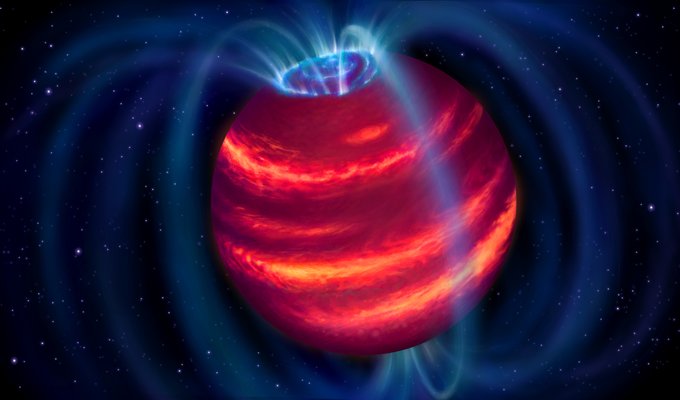The temperature at the centre of a brown dwarf is lower than 3 million degrees. This is “cold” compared to the core temperature of our Sun, which is 16 million degrees!

In an exciting discovery, astronomers have detected a "failed star" in a special new way: by radio waves!
Brown Dwarfs
As clouds of cosmic gas shrinks, they grow denser and hotter. When the temperature at the core reaches a scorching 10 million degrees, the clump officially flares into life as a bright new star. But not all collapsed clouds manage to reach the extreme temperatures needed to be born as a star. Those that don’t are known as failed stars, or ‘Brown Dwarfs’.
Like stars, brown dwarfs create their own light, because they are hot. They glow red and shine with invisible, infrared light (like the light used in remote controls). But brown dwarfs are smaller, dimmer and cooler than stars.
Collaboration for Success
Often in astronomy, collaboration between more than one organization or telescope leads to exciting results. Now, a collaboration between the LOw Frequency ARray radio telescope in Europe, the Gemini North telescope, and the NASA InfraRed Telescope Facility (both on Maunakea in Hawai‘i, USA) has led to the first direct discovery of a cold brown dwarf by using radio waves!
A First in Radio
Radio waves are a special type of light which we cannot see with our eyes. Radio telescopes here on Earth, like those used in this discovery, are used to study planets, comets, giant clouds of gas and dust, stars, and galaxies. By studying the radio waves that are coming from these sources, astronomers can learn about what they are made of and how they move. Radio waves are especially useful because they are not impacted by sunlight, clouds, or rain.
Previously, brown dwarfs were largely discovered using optical light (which we can see with our eyes) and/or infrared light (which can see through dust and clouds). So, this makes for an exciting first in radio astronomy. Not only is this an exciting new way for scientists to discover brown dwarfs, but this result also means astronomy has taken an exciting step in using radio astronomy to the exciting field of exoplanets.
Image credit: ASTRON/Danielle Futselaar





















